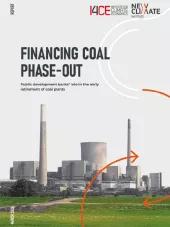This report was co-written by NewClimate Institute and the Institute for Climate Economics (I4CE).
The first global stocktake decision text calls to accelerate efforts “towards the phase-down of unabated coal power”. Associated with this discussion are the questions of how to bring about a just transition and shift towards renewables, but also of what to do with the existing infrastructure and sites. The caveat “unabated” opens the door for abatement technologies which threaten to undermine rapid phase-out efforts. Various phase-out strategies include propositions that promote co-firing with other fuels such as biomass, hydrogen, or ammonia. Others promote retrofitting existing infrastructure with carbon capture and storage technology.
With their historical role in funding coal capacity and public mandate, public development banks have a crucial role in enabling coal phase-out but should proceed cautiously to ensure they do not inadvertently set perverse incentives. As there is no consensus on a definition for transition finance nor technical criteria for qualifying sectors, there is a high risk of using scarce public funds to enable technologies that result in little decarbonisation impact.
This report explores many of the risks associated with proposals for abatement technologies and carbon credits in more detail as an input to current discussions on early coal retirement. The main arguments are highlighted below:
Co-firing
- Retrofitting to co-fire could create perverse incentives to keep plants online longer to recover not only the initial investment but also the costs associated with retrofitting.
- Co-firing or the potential to switch to an alternative fuel in the future should not be utilised as justification to extend the life of fossil fuel infrastructure today.
Complete conversion
- In most instances, plant conversion (to biomass) represents a false solution with incomplete emission reduction that does not eliminate the significant risk of stranding or the necessity for early retirement.
- Firing with synthetic fuels relies on the future availability of cost-competitive green fuels, a challenge that demands substantial production scaling and poses uncertainties.
Carbon capture (utilisation) and storage
- The technology faces several technical and economic challenges and is not currently a commercially viable option and available at a scale that would meet the demand indicated in national planning.
- CCS and CCUS offer incomplete emission reduction and often do not address pre-combustion emissions. Financing early retirement with carbon credits
Financing early retirement with carbon credits
- The use of credits as a mechanism to fund cutting emissions from coal generation, without robust safeguards, can introduce misaligned incentives and delay cutting emissions in other sectors.
Public development banks should exercise caution in engaging with coal phasedown to avoid setting perverse incentives that might extend plant lifetimes, offer incomplete emission reductions, and shift focus away from early retirement. Solutions that advocate cutting emissions while still relying on coal usage represent false solutions that fail to address the urgency of the climate crisis.
This report may be read in conjunction with a separate publication, Financing coal phase-out: Public development banks’ role in the early retirement of coal plants.








